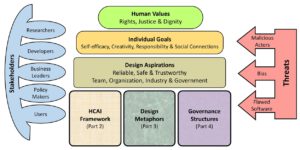Human-Centered Artificial Intelligence
Human-Centered AI
Ben Shneiderman, January 16, 2021, ben@cs.umd.edu
Published by Oxford University Press in January 2022.
A Human-Centered approach to Artificial Intelligence will ensure human control over powerful and helpful future mobile devices and services
Researchers, developers, business leaders, policy makers and others are expanding the technology-centered scope of Artificial Intelligence (AI) to include Human-Centered AI (HCAI) ways of thinking. This expansion from an algorithm-focused view to embrace a human-centered perspective, can shape the future of technology to better serve human needs. Educators, designers, software engineers, product managers, evaluators, and government agency staffers can build on AI-driven technologies to design products and services that make life better for people, enable people to care for each other, and support their creativity. Humans have always been tool builders, and now they are super-tool builders, whose inventions can improve our health, family life, education, business, the environment, and much more.
The remarkable progress in algorithms for machine and deep learning have opened the doors to new opportunities, and some dark possibilities. However, a bright future awaits AI researchers, developers, business leaders, policy makers and others who build on their working methods by including Human-Centered AI (HCAI) strategies of design and testing. As many technology companies and thought leaders have said, the goal is not to replace people, but to empower them by making design choices that give humans control over technology and support human creativity.
Human-Centered AI offers an optimistic, realistic, guide to how artificial intelligence can be used to augment and enhance humans’ lives. This project bridges the gap between ethical considerations and practical realities to make successful, reliable systems. Digital cameras, communications services, and navigation apps are just the beginning. Future applications will support health and wellness, improve education, accelerate business, and connect people in reliable, safe, and trustworthy ways that respect human values, rights, justice, and dignity.
Available from Amazon:
https://www.amazon.com/
and on the Oxford site:
https://global.oup.com/
Table of Contents
Part 1: What is Human-Centered Artificial Intelligence?
- Chapter 1: Introduction: High expectations
- Chapter 2: How do rationalism or empiricism provide sound foundations?
- Chapter 3: Are people and computers in the same category?
- Chapter 4: Will automation, AI, and robots lead to widespread unemployment?
- Chapter 5: Summary and skeptic’s corner
Part 2: Human-Centered AI Framework
- Chapter 6: Introduction: Rising above the levels of automation
- Chapter 7: Defining reliable, safe & trustworthy systems
Chapter 8: Two-dimensional HCAI framework - Chapter 9: Design guidelines and examples
- Chapter 10: Summary and skeptic’s corner
Part 3: Design Metaphors
- Chapter 11: Introduction: What is the goal of AI research?
- Chapter 12: Science and innovation goals
- Chapter 13: Intelligent agents and supertools
- Chapter 14: Teammates and tele-bots
- Chapter 15: Assured autonomy and control centers
- Chapter 16: Social robots and active appliances
- Chapter 17: Summary and skeptic’s corner
Part 4: Governance Structures
- Chapter 18: Introduction: How to bridge the gap from ethics to practice
- Chapter 19: Reliable systems based on sound software engineering practices
- Chapter 20: Safety culture through business management strategies
- Chapter 21: Trustworthy certification by independent oversight
- Chapter 22: Government interventions and regulation
- Chapter 23: Summary and skeptic’s corner
Part 5: Where Do We Go from Here?
- Chapter 24: Introduction: Driving HCAI forward
- Chapter 25: Assessing trustworthiness
- Chapter 26: Caring for and learning from older adults
- Chapter 27: Summary and skeptic’s corner
- Chapter 28: Personal Epilogue: How I became devoted to human-centered approaches
- Notes, Bibliography, Name Index, Subject Index



